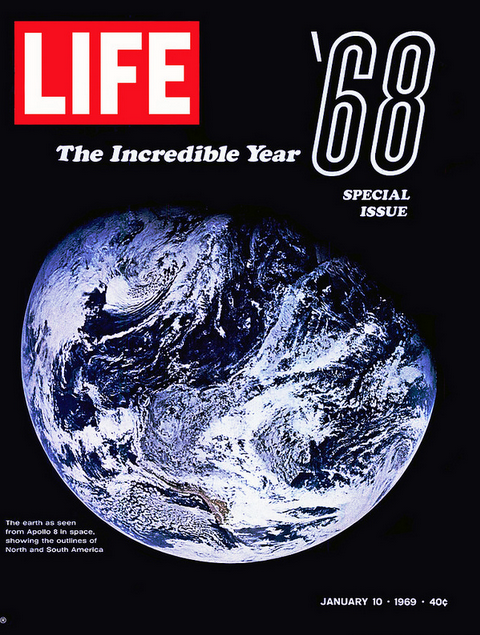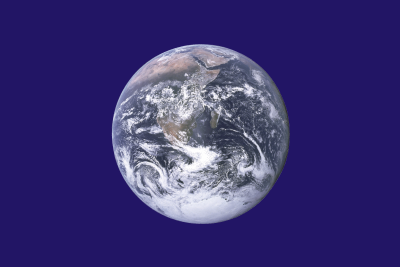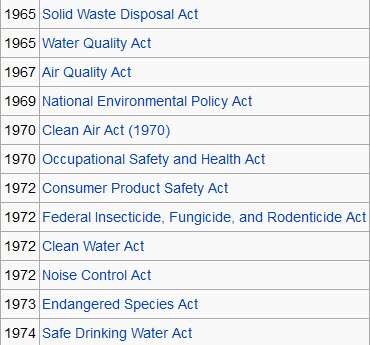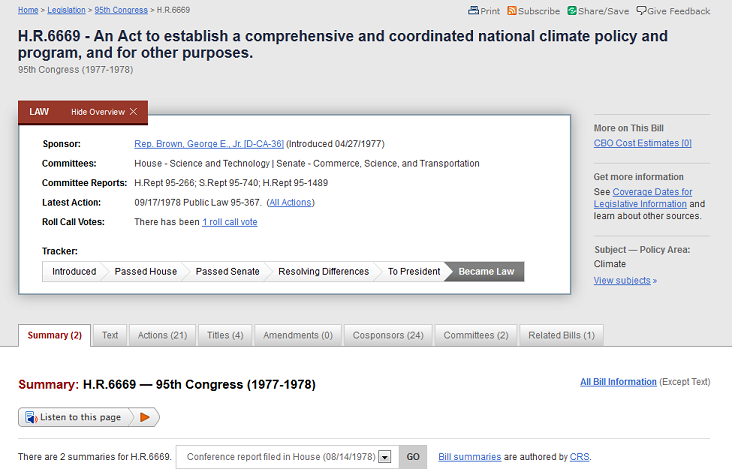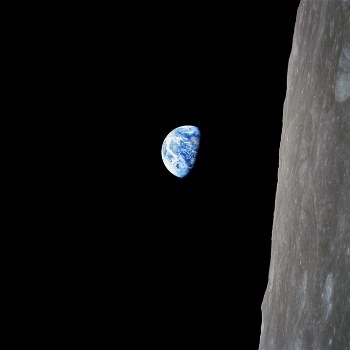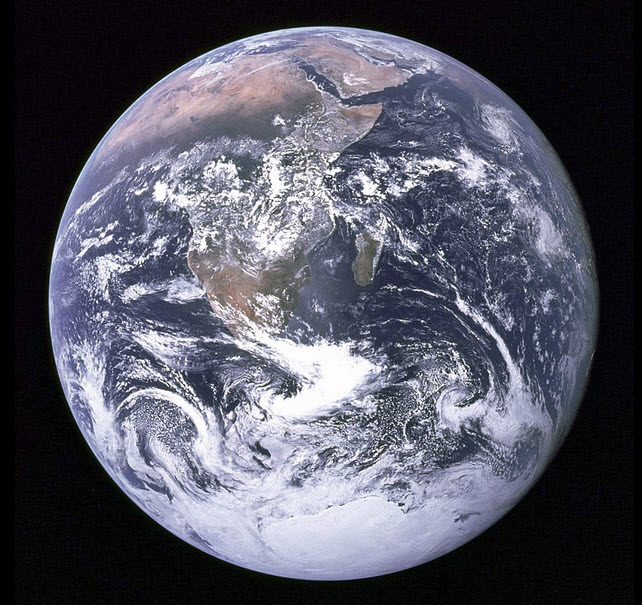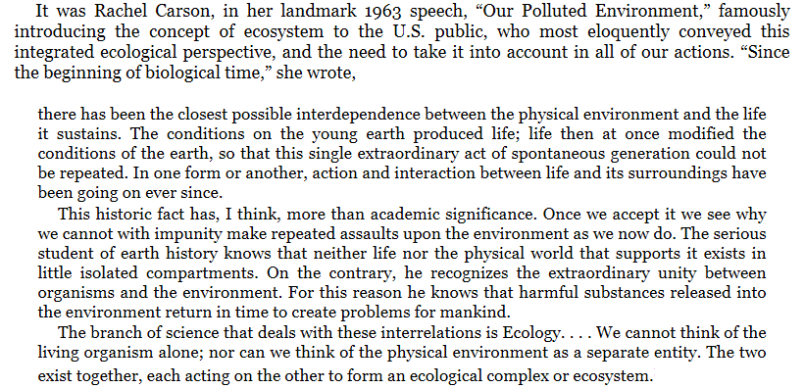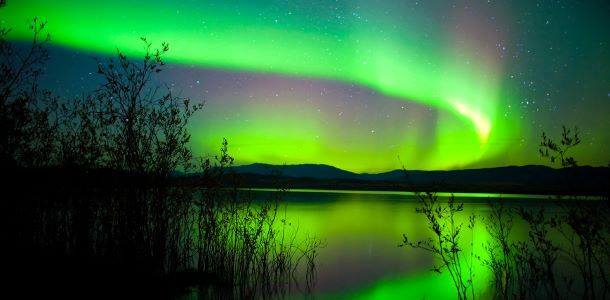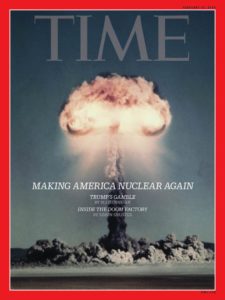Environmental movement: Difference between revisions
Siterunner (talk | contribs) No edit summary |
Siterunner (talk | contribs) No edit summary |
||
| Line 1: | Line 1: | ||
| Line 36: | Line 34: | ||
[[File:Apollo 8, Life Jan10,1969.png]] | [[File:Apollo 8, Life Jan10,1969.png]] | ||
:<small>'''Earthrise -- http://www.abc.net.au/science/moon/earthrise.htm'''</small> | |||
[[File:Earthrise - December 24, 1968.png | link=https://www.greenpolicy360.net/w/PlanetCitizen]] | |||
| Line 76: | Line 80: | ||
SJS / Siterunner: As many of us in the late 1960s on college campuses, looked to the future, we began to press politicians to join with us in environmental protection. Young political leaders like California's Jerry Brown and George Brown joined in with the new environmental movement. I personally was fortunate to work with Jerry and George in many ventures, including envisioning and drafting of first green legislation. Jerry was soon to become Governor and earn the moniker of "Governor Moonbeam" for his visionary ideas, and George became a key leader in national science policy, becoming Chair of the science/technology/space committee in the US House of Representatives. Initiatives were put before the president and Congress, were passed due to overwhelming public support that came about with student and 'out in front' vision, and these became models (as with many of GreenPolicy's green best practices networking sharing) models for cities/states/nations across the globe over the decades that came after the 1960s/70s/80s formative environmental years. Looking back we continue to see the foundation that was built on ... | |||
* ''http://www.greenpolicy360.net/w/George_E._Brown_Jr'' | |||
* ''http://www.greenpolicy360.net/mw/images/Can_our_environment_be_saved_George_Brown-Omnibus_Environmental_Bill_1969.pdf'' | * ''http://www.greenpolicy360.net/mw/images/Can_our_environment_be_saved_George_Brown-Omnibus_Environmental_Bill_1969.pdf'' | ||
| Line 119: | Line 126: | ||
:● ''http://www.greenpolicy360.net/w/Governor_Jerry_Brown'' | :● ''http://www.greenpolicy360.net/w/Governor_Jerry_Brown'' | ||
:● ''https://www.greenpolicy360.net/w/California_out_in_front_in_a_Green_future'' | |||
Revision as of 17:21, 19 March 2018
- GreenPolicy360, "Greening Our Blue Planet"
- Beginnings of the Modern Environmental Movement
SJS / Siterunner: The 1960's era was known for its citizen activism against a backdrop of war and global risks of nuclear weapons. Across the world many young people and activists were moved to work for peace, nuclear weapon reduction, and social justice. In the U.S., civil rights was challenging the old ways of politics and a "counterculture" of youthful vision stood out as the beginnings of a global environmental movement.
Against the existential threat of nuclear war and environmental disaster, realizations grew internationally that we had created weapons capable of ending humanity and most all life of earth. With a goal of protecting life, an environmental movement was born, a "Whole Earth" vision seen for the first time from space, and the very real 'sense' of our common responsibility for the future of the planet.
Many of the threads for the green era began with "teach-ins" and the first Earth Day in 1970 as students expanded counterculture to action. Across the US, a first Earth Day of teach-ins began as a student-initiated movement on college campuses including your siterunner's college at the University of Southern California. Earth Day's teach-ins reached out to students globally. A worldwide environmental movement was in the process of becoming real and growing as a political force...
- "I am convinced that the same concern the youth of this nation took in changing this nation's priorities on the war in Vietnam and on civil rights can be shown for the problems of the environment. Successful teach-ins on all campuses on the same day will have a dramatic impact on the environmental conscience of the nation. They will be immensely effective as an educational effort in arousing public opinion..."
- -- Senator Gaylord Nelson, April 23, 1970 at the University of Southern California
·······································································
http://www2.epa.gov/aboutepa/guardian-origins-epa
"American environmentalism dawned as a popular movement on a mild spring afternoon in 1970. Wednesday, April 22nd, brought blue skies, light breezes, and temperatures in the 60s to New York City and Washington, D.C. Much of the rest of the country enjoyed similar conditions. On that day, the influence of nature had particular meaning; the nation held a celebration of clean air, land, and water. Encouraged by the retreat of winter, millions participated."
"The first Earth Day may have been prompted... by the recent moon landings. When the astronauts turned their cameras homeward in December 1968, capturing first images of a blue planet, the world looked upon itself with awe and new whole-Earth understanding..."
- Earthrise -- http://www.abc.net.au/science/moon/earthrise.htm
Years later, the Environmental Protection Agency published its history, including these notable phrases:
"By late 1969, the subterranean rumblings heralding the impending explosion could already be heard... "Suddenly out of the woodwork come thousands of people talking about ecology."
"It was at just this time that Congress sent to the President a remarkable bill known as the National Environmental Policy Act (NEPA). Senator Gaylord Nelson (D-Wis)--looking back at the "Environmental Decade" in 1980--called NEPA "the most important piece of environmental legislation in our history."
Senator Gaylord Nelson recalls that right after the passage of NEPA, "the issue of the environment exploded on the country like Mount St. Helens."
○
SJS / Siterunner: Senator Nelson proposed an Earth Day event amid what he called the 'rumblings' and many of us in the student movement organized optimistically with our new 'whole Earth' vision. The profound issues of 60s, civil rights and the war in Vietnam led to what we called "the big picture". This led to seeing with new eyes, with planetary awareness. It became a time for looking ahead and alternatives to politics- and business-as-usual. The modern environmental movement sprang forward and, on April 22nd, the first Earth Day raised its flag.
"Planet Citizen / Planet Citizens"
- Earth Day flag
- ○ ○ ○ ○ ○ ○
A Modern Environmental Movement Is Born
● http://en.wikipedia.org/wiki/Environmental_policy_of_the_United_States
California and Environmental Politics in the US Congress: Out in Front
SJS / Siterunner: As many of us in the late 1960s on college campuses, looked to the future, we began to press politicians to join with us in environmental protection. Young political leaders like California's Jerry Brown and George Brown joined in with the new environmental movement. I personally was fortunate to work with Jerry and George in many ventures, including envisioning and drafting of first green legislation. Jerry was soon to become Governor and earn the moniker of "Governor Moonbeam" for his visionary ideas, and George became a key leader in national science policy, becoming Chair of the science/technology/space committee in the US House of Representatives. Initiatives were put before the president and Congress, were passed due to overwhelming public support that came about with student and 'out in front' vision, and these became models (as with many of GreenPolicy's green best practices networking sharing) models for cities/states/nations across the globe over the decades that came after the 1960s/70s/80s formative environmental years. Looking back we continue to see the foundation that was built on ...
- http://www.greenpolicy360.net/mw/images/National_Climate_Program_Act_Public_Law_95-367_Sept_1978.pdf
Environmental Policy Laws: The Beginnings of a New Era
- ·····················································································
"The Magna Carta of the country’s national environmental laws..."
································································
The First Federal Climate Study Plan
○
Green Appreciation for the Vision & Leadership of Two Browns from California -- 'George & Jerry'
○
http://www2.epa.gov/aboutepa/epa-order-11102
http://www2.epa.gov/aboutepa/birth-epa
http://www2.epa.gov/aboutepa/guardian-epas-formative-years-1970-1973
○ ○ ○ ○ ○ ○ ○ ○ ○ ○ ○ ○ ○ ○ ○ ○ ○ ○ ○ ○ ○ ○ ○ ○ ○ ○ ○ ○ ○ ○
Unprecedented environmental protection bills began a process that continues to this day...
Green, environmental public policies, a foundation on which to build sustainable quality of life...
Water quality act
http://www.encyclopedia.com/article-1G2-3456400109/water-quality-act-1965.html
Air quality act http://scholarship.law.duke.edu/cgi/viewcontent.cgi?article=3197&context=lcp
National environmental policy act http://en.wikipedia.org/wiki/National_Environmental_Policy_Act
Occupational safety and health act http://en.wikipedia.org/wiki/Occupational_Safety_and_Health_Act
Consumer product safety act http://en.wikipedia.org/wiki/Consumer_Product_Safety_Act
Federal insecticide, fungicide and rodenticide act http://www.epa.gov/agriculture/lfra.html
Clean water act http://en.wikipedia.org/wiki/Clean_Water_Act
Noise control act http://en.wikipedia.org/wiki/Noise_Control_Act
Endangered species act http://www.fws.gov/endangered/laws-policies/
Safe drinking water act http://water.epa.gov/lawsregs/guidance/sdwa/basicinformation.cfm
·······················
Whole Earth
Origins of the modern environmental movement: Seeing the whole earth for the first time
Circa 1969
○ ○ ○ ○ ○ ○ ○ ○ ○ ○ ○ ○ ○ ○ ○ ○ ○ ○ ○ ○ ○ ○ ○ ○ ○
The Apollo 8 Earthrise Photo
http://en.wikipedia.org/wiki/Earthrise
http://www.greenpolicy360.net/w/File:Earthrise_book_cover_%282008%29.jpg
http://www.ibhanet.org/resources/documents/newsletters/spierearthrisephoto.pdf
http://www.greenpolicy360.net/w/File:Apollo_Earth_350x350.jpg
http://www.greenpolicy360.net/w/File:Apollo.jpg
○ ○ ○ ○ ○ ○ ○ ○ ○ ○ ○ ○ ○ ○ ○ ○ ○ ○ ○ ○ ○ ○ ○ ○ ○ ○
...and in 1972, an exclamation point, Apollo 17's image of "Blue Marble" Planet Earth
http://www.greenpolicy360.net/w/Apollo_17
○
And in Memory of Rachel and Her Eye-Opening Science
○
'And Tip of the Green Cap' to David Brower
David Brower quoting Goethe -- “Whatever you can do or dream you can, begin it. Boldness has genius, power and magic in it!”
SJS / Siterunner recalling one of David's favorite quotes as we worked on Green Education projects together with Danny Moses of Sierra Club books.
Recalling David, shortly before his death in 2000, flying to Denver, Colorado, to attend the Green Party's presidential nominating convention and the approval of the founding Green Platform. In an interview: "Ralph is doing what we need to do if we really care about the planet... I'm old... but I'm relying on a lot of young people..." One of David's last acts was to cast his absentee ballot for Ralph.
And to Aldo Leopold for Ethics & Fire
http://aldoleopold.org/greenfire/about.shtml
○
Among the Actions / Issues Moving Forward thru the Modern Environmental Movement
● https://www.greenpolicy360.net/w/Category:Civil_Liberties
● https://www.greenpolicy360.net/w/Category:Civil_Rights
● https://www.greenpolicy360.net/w/Category:Human_Rights
● https://www.greenpolicy360.net/w/Category:Environmental_Laws
● https://www.greenpolicy360.net/w/Category:Clean_Air
● https://www.greenpolicy360.net/w/Category:Clean_Water
● https://www.greenpolicy360.net/w/Category:Environmental_Protection
● https://www.greenpolicy360.net/w/Category:Eco-nomics
● https://www.greenpolicy360.net/w/Category:Alternative_Agriculture
● https://www.greenpolicy360.net/w/Category:Food
● https://www.greenpolicy360.net/w/Category:Earth_Day
● https://www.greenpolicy360.net/w/Category:Green_Politics
● https://www.greenpolicy360.net/w/Category:Global_Security
● https://www.greenpolicy360.net/w/Category:Renewable_Energy
● https://www.greenpolicy360.net/w/Category:Green_Business
● https://www.greenpolicy360.net/w/Ecofeminism
● https://www.greenpolicy360.net/w/Category:Rights_of_Nature
● https://www.greenpolicy360.net/w/Category:Sustainability_Policies
··················································
Nuclear Weapons, Nonproliferation v. Proliferation
In 2007, the late Jonathan Schell spoke presciently about the relationship between nuclear weapons and climate change:
“When I wrote The Fate of the Earth in 1982, I said that, first and foremost, nuclear weapons were an ecological danger. It wasn’t that our species could be directly wiped out by nuclear war down to the last person. That would only happen through the destruction to the underpinnings of life, through nuclear winter, radiation, ozone loss.
There has been an oddity of timing because when the nuclear weapon was invented, people didn’t even use the word ‘environment’ or ‘ecosphere.’ The environmental movement was born later. So in a certain sense the most urgent ecological threat of them all was born before the context in which you could understand it. The present larger ecological crisis in that context.
In other words, global warming and nuclear war are two different ways that humanity threatens to undo the natural underpinnings of human, and of all other, life... we may be in a better position today because of global warming, to grasp the real import of nuclear danger.”
- A Horror Beyond Comprehension - https://www.nytimes.com/books/98/12/06/specials/schell-fate.html
○
- Alternative Agriculture
- Atmosphere
- Atmospheric Science
- Biodiversity
- Clean Air
- Clean Water
- Earth
- Earth Day
- Earth Science
- Earth360
- EarthPOV
- Eco-nomics
- Eco-Spirituality
- Ecology Studies
- Ecotourism
- Education
- Energy Policy
- Environmental Laws
- Environmental Protection
- Environmental Security
- EOS eco Operating System
- Forests
- Green Energy Initiatives
- Green Politics
- Green Values
- Health
- Natural Resources
- Nuclear Nonproliferation
- Oceans
- Peace
- Renewable Energy
- Resilience
- Strategic Demands
- Sustainability
- US Environmental Protection Agency
- Water Quality
- Whole Earth
